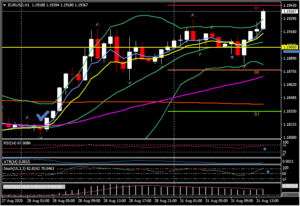EURUSD, H1
The Dollar posted fresh trend lows against some currencies before recovering in low volume, (London is closed today) end-of-month re-balancing trades. The framework regime shift at the Fed, announced by Chairman Powell last week, effectively reaffirmed the dollar softening trend, concomitantly with shorter dated inflation-adjusted Treasury yields posting fresh lows. The yields on the 5- and 7-year real constant maturity Treasury notes were indicated on Friday at new seven-year-plus lows, at -1.40% and -1.26% respectively (down by a respective 15 bp and 11 bp from week-before levels). The narrow trade-weighted USDIndex (DXY) logged a new 27-month low at 92.11, and is set to rack August up as a fourth consecutive month of descent and the worst August for five years. EURUSD printed a high at 1.1938, which drew back in on the 27-month high seen a couple of weeks back at 1.1967. This puts the pair on course to make this the thirteenth up week that’s been seen out of the last sixteen weeks. For now, the softer dollar theme looks likely to remain in play. But there are forces that may weaken this trend. One is that incoming US data has been showing ongoing economic recovery in the US. Another is that the ECB is also considering average inflation targeting with the aim of increasing inflation expectations, which would presumably weigh on the Euro. The Eurozone’s economic recovery may also flatten as a consequence of renewed restrictions for hospitality and travel operators. This was the prime cause for preliminary August services PMI surveys missing consensus expectations. Governments in most European countries (Sweden being the main exception) remain somewhat trigger happy in imposing localised restrictions in response to upward flurries in positive coronavirus tests — even though there hasn’t been any significant correspondence of actual public health events (serious illness and associated hospitalisations and deaths). The death rate from all respiratory illnesses outside Covid-19 has been greater than for Covid itself for some time now, and all-cause mortality rates continue to trend below long-term averages.
Elsewhere, Cable posted a fresh eight-month peak at 1.3367 before retreating to 1.3332. AUDUSD lifted to a new trend peak at 0.7382, which is the loftiest level the pair has seen since December 2018. NZDUSD saw an eight-month high at 0.6740. USDCAD sank back below 1.3100 but remains shy of Friday’s seven-month low at 1.3045. Like other oil correlating currencies, the Canadian Dollar lost upside momentum as crude prices pared gains from the highs that were seen mid last week. Hurricane Laura wasn’t as disruptive to Gulf of Mexico crude production as feared. USDJPY is higher on the back of yen underperformance, rising to the lower 105.90’s, retracing some of the declines seen on Friday from levels near 107.00. AUDJPY, meanwhile, has lifted by over 0.7% but has remained short of last week’s 18-month peak. EURJPY, GBPJPY and other yen crosses have also lifted, but have also remained below recent highs.
Click here to access the HotForex Economic Calendar
Stuart Cowell
Head Market Analyst
Disclaimer: This material is provided as a general marketing communication for information purposes only and does not constitute an independent investment research. Nothing in this communication contains, or should be considered as containing, an investment advice or an investment recommendation or a solicitation for the purpose of buying or selling of any financial instrument. All information provided is gathered from reputable sources and any information containing an indication of past performance is not a guarantee or reliable indicator of future performance. Users acknowledge that any investment in Leveraged Products is characterized by a certain degree of uncertainty and that any investment of this nature involves a high level of risk for which the users are solely responsible and liable. We assume no liability for any loss arising from any investment made based on the information provided in this communication. This communication must not be reproduced or further distributed without our prior written permission.




















